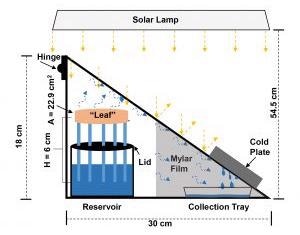Jun 23 2021
The United Nations reports that around 2.2 billion people face a shortage of reliable access to clean drinking water throughout the world, and the increasing impacts of climate change could probably worsen this condition.
 Transpiration-powered synthetic tree. Image Credit: Ndidi Eyegheleme.
Transpiration-powered synthetic tree. Image Credit: Ndidi Eyegheleme.
Solar steam generation (SSG) has materialized as a potential renewable energy technology for water harvesting, purification and desalination that could help people who require it the most in developing nations, disaster-relief areas and remote communities.
In the journal Applied Physics Letters, from AIP Publishing, scientists from Virginia Tech have reported the development of a synthetic tree to improve SSG.
SSG involves the conversion of solar energy into heat. Water from a storage tank constantly wicks up small and floating porous columns. As soon as the water reaches the photothermal material layer, it starts evaporating, and then the steam is condensed into drinking water.
As far as the SSG technology is concerned, one main difficulty in scaling it up is the limit in the capillary force over a specific column height, wherein the water cannot wick quick enough to sustain the evaporation process. The capillary force that depends on the surface tension that makes the water “climb” a porous paper towel forces the water towards the evaporator.
The scientists have gained inspiration from the mangrove trees that thrive along the coastlines and have overcome this obstacle by making a synthetic tree to substitute the capillary action with transpiration. It is the process of the movement of water via a plant and its evaporation from flower stems and leaves. Transpiration has the potential to pump water up insulating tubes of any preferred height.
In fact, transpiration begins in the roots of real trees themselves, which tend to absorb water with the help of hollow vessels that are made from xylem tissue. As the water gets warmer, it discharges as vapor through pores on the underside of leaves.
The synthetic tree is composed of a 19-tube array that is covered by a nonporous ceramic disk, which acts as the leaf. Each plastic tube imitates the xylem conduits measures and is 6 cm high, somewhat less than 2.5″, with an inner diameter of 3.175 mm, which is about one-tenth of an inch.
The setup allows the evaporating interface to split thermally from the huge water in the tank so that the evaporator is not dehydrated. The water that evaporates from the disk is refilled by suction, which constantly helps to pump more water from a bottom tank up the tube array.
We expect our tree-based solar steam generator will be of interest for applications in underground water extraction and purification. The ultimate goal is to achieve a suction pressure strong enough to pull ocean water through a salt-excluding filter without requiring a mechanical pump, analogous to how mangrove trees are able to grow in ocean water.
Jonathan B. Boreyko, Department of Mechanical Engineering, Virginia Polytechnic Institute and State University
More studies could concentrate on making taller trees, thereby adding more leaves to increase the area over which evaporation takes place, and integrating desalination membranes at the tube inlets to avoid the accumulation of salt.
Journal Reference:
Hill, M. D., et al. (2021) Perspective on ceramic materials for 5G wireless communication systems. Applied Physics Letters. doi.org/10.1063/5.0036058.